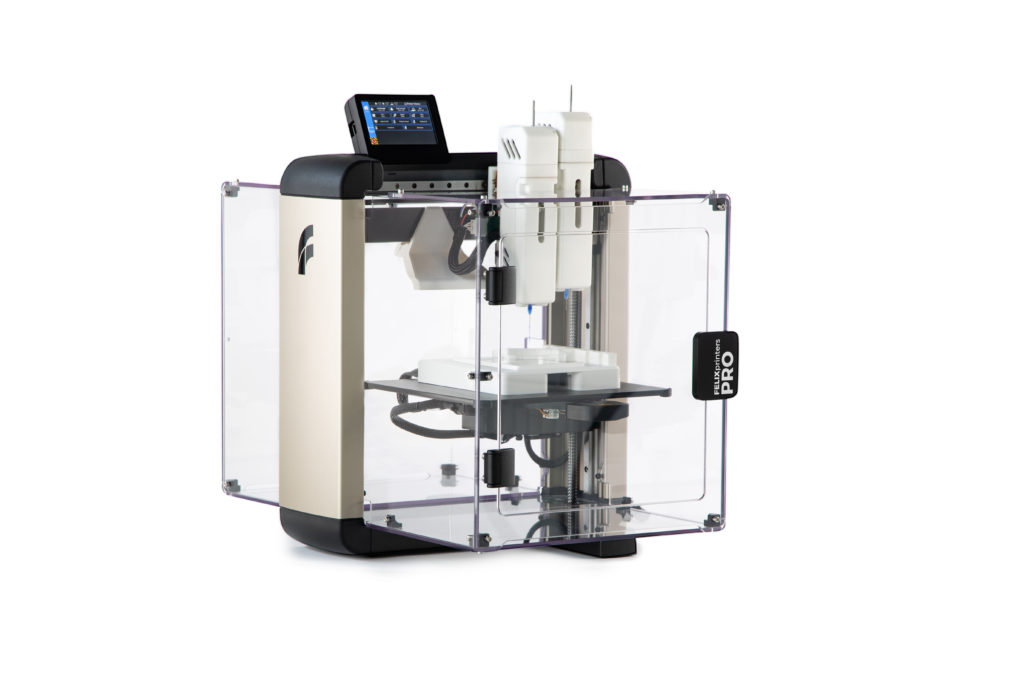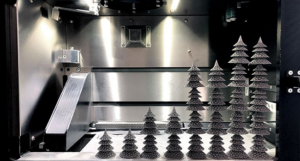FELIXprinters Launches Its First Bioprinter the FELIX BIOprinter
 If we could visualize the future of medicine, drug testing, and artificial tissue and organ development, we would most certainly find bioprinters in the spotlight. Part of the vanguard vision of many companies and researchers alike is that the machines will become a familiar resource used in every bioengineering lab, university and even school around the globe. But building up to that momentum might take many years, even decades, yet this is becoming one of the most interesting times for the field, with a widening array of companies boosting bioprinting technology commercially, we can’t help but get excited when we hear about recent advances and newly launched machines.
If we could visualize the future of medicine, drug testing, and artificial tissue and organ development, we would most certainly find bioprinters in the spotlight. Part of the vanguard vision of many companies and researchers alike is that the machines will become a familiar resource used in every bioengineering lab, university and even school around the globe. But building up to that momentum might take many years, even decades, yet this is becoming one of the most interesting times for the field, with a widening array of companies boosting bioprinting technology commercially, we can’t help but get excited when we hear about recent advances and newly launched machines.“The BIOprinter has been designed to be the ultimate bio research instrument in a cost-effective package, and has been developed alongside the brightest minds in the bioprinting sector,” suggested Wilgo Feliksdal, co-founder of FELIXprinters. “Uniquely, the BIOprinter combines dual sterilizable printheads which have a modular design for easy changeovers, and separate heads are available to print different bioinks at the same time. This integrates different material properties into a single scaffold structure.”
It is also equipped with a touchscreen that has a user-friendly interface and embedded print server that allows remote print file monitoring, use in a multi-user environment, and print-file management. A nozzle probing system enables automated bed leveling and calibration of the nozzles, plus a camera module that allows users to monitor prints remotely from their smartphone or computer complete the features of this machine. FELIX indicates that the BIOprinter also retracts with a highly precise motor for better dosage or materials and more accurate material flow versus alternative air pressure systems.
“The BIOprinter consists of an adaptable and flexible ecosystem to ensure that it can meet a wide range of researchers’ needs without generating unnecessary costs. One major advantage is the source control system which enables the user to use standard slicing software and make changes themselves if needed. Also, syringes are not restricted to expensive brand-specific or in-house produced products that essentially drive up operating costs. The machine instead has been designed to use a standard 5ml syringe, and standardized Petri dishes and culture plates, so there are no limitations on auxiliary parts and materials,” continued Feliksdal.
A big plus is that the machine uses familiar slicing software Simplify 3D, to allow fully in-control and customizable user experience. The BIOprinter is also WIFI and LAN enabled, comes with a one-year warranty, and lifetime customer support.
The post FELIXprinters Launches Its First Bioprinter the FELIX BIOprinter appeared first on 3DPrint.com | The Voice of 3D Printing / Additive Manufacturing.
Sustainability in additive manufacturing?
2019 has been the year of environmental sustainability, with global protests and increased political and social focus. The additive manufacturing industry isn’t an exception; sustainability is on the agenda. But how?
We are entering a new era for additive manufacturing now. One in which the increase in adoption for production applications requires the industry to mature and demonstrate the reliability, repeatability and quality of more established manufacturing techniques. This was clear during the recent Formnext 2019, where there was a significant message coming from most OEM’s, which was more focused on delivering on previous promises made of their technology. During the recent Formnext 2019, newly appointed CEO of EOS, Marie Langer, was asked about her priorities for the coming years, she discussed a focus on delivering repeatable and transferable processes, usability, quality and reliability. However, there was another significant topic that came up during that press event, and as the week progressed, it was a topic widely discussed on the Formnext floors. The topic was sustainability in additive manufacturing.

The topic was discussed in press conferences, in panel discussions, at networking events, and in one-on-one conversations.
For Marie Langer sustainability is a critical subject and one the whole industry should be championing. This was echoed by Brian Neff, CEO of Sintavia, who also commented on the opportunity and advantage AM has, as a more sustainable production technology than traditional subtractive manufacturing technologies. Langer spoke about developing more sustainable materials that could be recycled and re-used. Brian highlighted that for metal AM, there is far less material waste and that through distributed manufacturing, shipping could be reduced and therefore the overall carbon footprint of producing a part could be lowered.

The topic of sustainability was also taken up by Rush LaSelle, Senior Director, Additive Manufacturing, at Jabil Additive, as he was on a panel on Formnext TV. LaSelle described the benefits of distributed manufacturing from the perspective of sustainability. Moreover, senior leaders in companies like Carpenter Additive, HP, and DSM, made it clear, that sustainability is on the agenda. Camille Caron, HP’s Director of Education and Sustainability for their 3D printing business has recently written an article about this topic.
It seems clear that AM has the opportunity to lead the global manufacturing market as a sustainable production technology. The benefits offered through reduced material waste, supply chain innovations that reduce the needs for shipping parts thousands of miles, the use of recycled plastics and metals in materials, as well as the development of new recyclable materials, can all position AM as the most sustainable production solution for companies. It comes at a time where large companies are all under pressure to reduce carbon footprint and do more to protect and preserve the environment. Therefore this opportunity is one that could further support the acceleration of the AM industry as a whole. However, while this topic was widely talked about at a senior level, there is still very little being done to actually drive sustainability initiatives. Part of that problem likely lies with the question “Who is responsible?”. How many AM organisations, be they machine OEM’s, Materials Companies etc. have a Head of Sustainability, or at least an internal champion to take ownership? This is something Alexander Daniels Global are going to explore more and early in 2020 plan to prepare a report looking directly at what the major companies are doing to further this very important cause.
By Nick Pearce, Director of Alexander Daniels Global
The post Sustainability in additive manufacturing? appeared first on 3DPrint.com | The Voice of 3D Printing / Additive Manufacturing.
3D Printing News Briefs: November 25, 2019
We’re finishing the week out with some more formnext news for 3D Printing News Briefs: Poly-Shape presented a metal 3D printed Francis Turbine at the event. Moving on, Etihad Engineering opened a 3D printing lab for aircraft parts with EOS and BigRep, and Y Soft launched an online collection of 3D lessons for educators.
Poly-Shape’s 3D Printed Francis Turbine
 At formnext 2019 last week, French company Poly-Shape presented something rather unique: a 72 kg Francis Turbine made with its Directed Energy Deposition-powder (DED-P) metal 3D printing technology. Turbine components are often used in the aerospace and energy industries, and DED-P printing can be used to fabricate the raw part, with its complex geometry, in less than 3 days; in fact, the Francis Turbine was printed in just 55 hours.
At formnext 2019 last week, French company Poly-Shape presented something rather unique: a 72 kg Francis Turbine made with its Directed Energy Deposition-powder (DED-P) metal 3D printing technology. Turbine components are often used in the aerospace and energy industries, and DED-P printing can be used to fabricate the raw part, with its complex geometry, in less than 3 days; in fact, the Francis Turbine was printed in just 55 hours.
“The DED-P process is operated within a 5-axis CNC machine thanks to a material depositing system,” a Poly-Shape press release stated.
“By minimizing the needed allowance (typically < 1,5 mm), the part machining is reduced to finishing operation. In case of hard to access areas, the DED and the machining production can be sequenced such as the tool accessibility would be released.”
Etihad’s 3D Printing Lab for Aircraft Parts
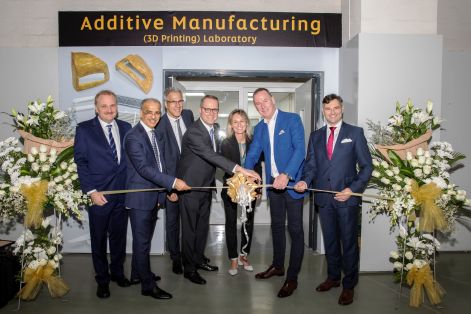
Bernhard Randerath, VP Design, Engineering & Innovation, Etihad Engineering; Abdul Khaliq Saeed, CEO, Etihad Engineering; Markus Glasser, SVP EOS; H.E. Ernst Peter Fischer, German Ambassador to the UAE; Marie Langer, CEO EOS; Tony Douglas, Group CEO Etihad Aviation Group; Martin Black, CEO BigRep.
Etihad Engineering, a division of the Etihad Aviation Group, partnered with EOS and BigRep to open a 3D printing lab. It’s one of the first airline MROs in the Middle East that’s received approval from the European Aviation Safety Agency (EASA) for designing, producing, and certifying cabin parts made with powder bed fusion technology, two years after receiving approval for filament 3D printing. The laboratory is located at the Etihad Engineering facility, adjacent to Abu Dhabi International Airport, and houses two industrial 3D printers – the EOS P 396 and the BigRep ONE. It was opened officially in a ceremony last week, and in recognition of the relationships between Etihad, EOS, and BigRep, was attended by His Excellency Ernst Peter Fischer, German Ambassador to the UAE.
“The launch of the new facility is in line with Etihad Engineering’s position as a leading global player in aircraft engineering as well as a pioneer in innovation and technology,” said Bernhard Randerath, VP Design, Engineering and Innovation for Etihad Engineering. “We are extremely proud to collaborate with EOS and BigRep to expand our capability and support the UAE’s strategy to increase production technology and cement its position as a global aerospace hub.”
Y Soft Launches be3D Academy for Educators
 The Y Soft Corporation has launched its be3D Academy, available as part of its YSoft be3D eDee 3D printing solution for education. There are many benefits to using classroom 3D printing as a tool for learning, and adoption in schools is growing fast, but developing lesson plans that incorporate the technology can be difficult, due to lack of knowledge or access. The company’s new online collection of teacher-tested 3D lesson plans in STEAM subjects make it easy for educators to teach in 3D. The be3D Academy lesson plans provide tools like student worksheets, presentations, video tutorials, and 3D model files, all of which can be made on the YSoft be3D eDee printer with its certified filaments.
The Y Soft Corporation has launched its be3D Academy, available as part of its YSoft be3D eDee 3D printing solution for education. There are many benefits to using classroom 3D printing as a tool for learning, and adoption in schools is growing fast, but developing lesson plans that incorporate the technology can be difficult, due to lack of knowledge or access. The company’s new online collection of teacher-tested 3D lesson plans in STEAM subjects make it easy for educators to teach in 3D. The be3D Academy lesson plans provide tools like student worksheets, presentations, video tutorials, and 3D model files, all of which can be made on the YSoft be3D eDee printer with its certified filaments.
“3D printing is particularly valuable in the classroom to convey complex subjects. When students can touch and adjust physical objects they have created, understanding increases. Comprehension of STEAM subjects can be difficult, and be3D Academy’s lessons make concepts interesting and fun. be3D Academy lesson plans range from creating castles to understanding geometric shapes and volumes to creating a Da Vinci bridge as a science learning project,” said Elke Heiss, the Y Soft Chief Marketing Officer.
The be3D Academy is open to all educators looking to add 3D printing to their classrooms.
Discuss these stories and other 3D printing topics at 3DPrintBoard.com or share your thoughts in the Facebook comments below.
The post 3D Printing News Briefs: November 25, 2019 appeared first on 3DPrint.com | The Voice of 3D Printing / Additive Manufacturing.
Oerlikon at Formnext 2019: 3D printed rocket parts, post-processing, and digital factories
Additive Manufacturing Technologies unveils integrated post-processing Digital Manufacturing System at Formnext 2019
ExOne forms multiple partnerships to simplify sintering for metal binder jet 3D printing
EOS debuts Fine Detail Resolution 3D printing at Formnext 2019
EnvisionTEC and Sartomer develop water-soluble resin for cDLM 3D printers
3D Printing News Briefs: November 20, 2019
We’re starting out with some formnext news in today’s 3D Printing News Briefs, as the show is currently taking place in Frankfurt this week. SCANLAB is introducing a new scan system control extension at the show. We also have some metal stories today – Desktop Metal has launched 4140 chromoly steel for its Studio System, while QuesTek Innovations and the German Aerospace Center are exploring the potential of a high-temperature aluminum alloy. Moving on, XJet’s Carmel 1400 AM system was installed at KU Leuven University. Finally, Additive Minds investigated EOS 3D printing without the use of supports.
SCANLAB Integrating Process Data into 3D Printing
 Laser scanning solutions manufacturer SCANLAB GmbH is at formnext 2019 this week, and will be introducing a scan system control extension that uses a smart data-acquisition interface that reads external sensors. It’s a functioning model of an intelligent interface, and can integrate sensor data into scan system control – giving AM users the ability to inquire about, and evaluate, centralized process data.
Laser scanning solutions manufacturer SCANLAB GmbH is at formnext 2019 this week, and will be introducing a scan system control extension that uses a smart data-acquisition interface that reads external sensors. It’s a functioning model of an intelligent interface, and can integrate sensor data into scan system control – giving AM users the ability to inquire about, and evaluate, centralized process data.
Two tradeshow demonstrators were created that show how diverse the integrable sensor range is. The first incorporates a surface-temperature pyrometer into the scan head control, and the sensor system’s data merges with laser beam position data. In the second, an OCT (optical coherence tomography) sensor from Precitec is integrated to measure the powder bed’s surface topography. Visit SCANLAB at formnext this week at Booth B41, Hall 12.0.
Desktop Metal Launches 4140 Chromoly Steel for Studio System
 Massachusetts-based company Desktop Metal is expanding its material portfolio by launching 4140 chromoly steel for industrial applications for its office-friendly Studio System. 4140 is a versatile material, with high tensile strength, abrasion and impact resistance, and toughness. DM Studio Systems users can now use this material to 3D print parts like connecting rods, couplings, pinions, press brake tools, and more for industries including automotive, agriculture, industry, and defense.
Massachusetts-based company Desktop Metal is expanding its material portfolio by launching 4140 chromoly steel for industrial applications for its office-friendly Studio System. 4140 is a versatile material, with high tensile strength, abrasion and impact resistance, and toughness. DM Studio Systems users can now use this material to 3D print parts like connecting rods, couplings, pinions, press brake tools, and more for industries including automotive, agriculture, industry, and defense.
“As global demand for the Studio System grows, Desktop Metal is broadening its materials portfolio to include 4140 chromoly steel, enabling designers and engineers to print a broad variety of critical industrial applications, such as couplings, forks, pinions, pump shafts, sprockets, torsion bars, worm gears, connecting rods, and fasteners. Now, teams around the world will be able to leverage the Studio System to iterate quickly on 4140 prototypes and ultimately produce end-use, customer-ready parts faster and more cost-effectively,” said Desktop Metal’s CEO and Co-Founder Ric Fulop.
QuesTek’s 3D Printable Aluminum Alloy
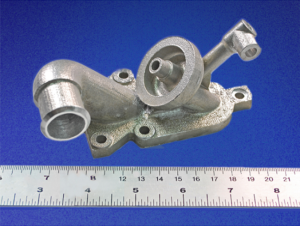 Integrated Computational Materials Engineering (ICME) technologies leader QuesTek Innovations LLC and the German Aerospace Center (DLR) are working on a joint project to explore the potential of QuesTek’s new 3D printable high-temperature aluminum (Al) alloy. The material, able to perform at temperatures between 200-300°C in its as-built condition, is being developed by QuesTek under several US Navy-funded Small Business Innovation Research awards, and is believed to be the first powdered Al alloy to meet necessary requirements without any subsequent heat treatment. The DLR will be 3D printing demonstration components with the material, which can be used to fabricate more lightweight precision components like heat exchangers.
Integrated Computational Materials Engineering (ICME) technologies leader QuesTek Innovations LLC and the German Aerospace Center (DLR) are working on a joint project to explore the potential of QuesTek’s new 3D printable high-temperature aluminum (Al) alloy. The material, able to perform at temperatures between 200-300°C in its as-built condition, is being developed by QuesTek under several US Navy-funded Small Business Innovation Research awards, and is believed to be the first powdered Al alloy to meet necessary requirements without any subsequent heat treatment. The DLR will be 3D printing demonstration components with the material, which can be used to fabricate more lightweight precision components like heat exchangers.
“The accelerated design and development of a printable aluminum alloy capable of meeting so many current needs is especially exciting, as it will enable concurrent design of material composition and component geometry,” stated Greg Olson, QuesTek Chief Science officer. “Based on our internal test results, we see broad application of this material in manufacturing components for aerospace, satellite, automotive and high-performance racing.
“We are particularly pleased to be collaborating with the DLR. Their unrivaled reputation, expertise and close relationship with industry needs will bring an important new scope to our efforts.”
XJet’s Carmel 1400 3D Printer Installed at KU Leuven University
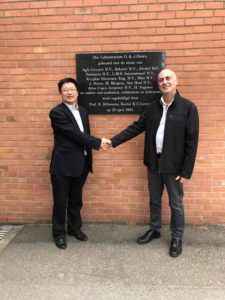
Professor Shoufeng Yang, KU Leuven, shakes hands with Avi Cohen, VP of Healthcare and Education at XJet.
For the first time, a 3D printing system has been installed at a European academic institution. XJet recently delivered its Carmel 1400 AM system to the KU Leuven University in Belgium, where it will be used to for university research and to help develop regional 3D printing medical opportunities. The 3D printer, and its proprietary NanoParticle Jetting (NPJ) technology, will be put to good use at the European research center, as academics will used it to explore medical applications and AM educational and research purposes. XJet’s zirconia material will also be used to 3D print ceramic medical models.
“Since the Carmel was installed, we are already reaping the benefits. The XJet system offers the high levels of precision and exceptional detailing required, levels which were previously impossible or extremely time-consuming in post-processing. The use of soluble support materials, with no harmful powders, makes it a much easier process and opens up opportunities to innovate that simply did not exist before,” said Professor Shoufeng Yang, who is heading the AM research at KU Leuven. “It’s an amazing and fantastic technology for R&D in universities and for the manufacturing industry, and it’s very exciting to be a part of. I believe that this is the best ceramic additive manufacturing method which can be easily upgraded into future multi-materials additive manufacturing, which is a grand challenge in the AM industry.”
XJet is also attending formnext this week – you can find the company at stand #C01 in Hall 12.1.
3D Printing Without Supports
Michael Wohlfart, DMLS Process Consultant for the EOS Additive Minds Process Consulting team, wrote an article on LinkedIn, titled “Building without support? Possibilities and limitations,” about the design aspect of printing without supports in metal powder bed fusion technology, which can reduce build time, material consumption, and cost. The three main reasons for supports are heat transfer, residual stress, and recoater forces, but there are workarounds for all three. In recoater forces, forces are acting on the part while spreading powder, and the recoater will wipe away parts not connected to the baseplate. Prop supports, such as cones and stacking parts, can be used to negate the need for a baseplate connection. Wolfhart discussed a few examples that were 3D printed on an EOS M290 out of titanium.
“Let’s move on to a more advanced design and even incorporate stacking,” Wohlfart wrote. “Since Christmas season is coming up, how about a Christmas tree designed with Siemens NX and pimped with nTopology? By turning it upside-down, the tree is self-supporting and the tree trunk can act as a shell for the next tree. You can see a small overlap of 0.1 mm in x-y-direction between the lattice and the solid parts in order to assure a good connection.”
To learn more, check out Wohlfart’s LinkedIn post.
Discuss these stories and other 3D printing topics at 3DPrintBoard.com or share your thoughts in the Facebook comments below.
The post 3D Printing News Briefs: November 20, 2019 appeared first on 3DPrint.com | The Voice of 3D Printing / Additive Manufacturing.

